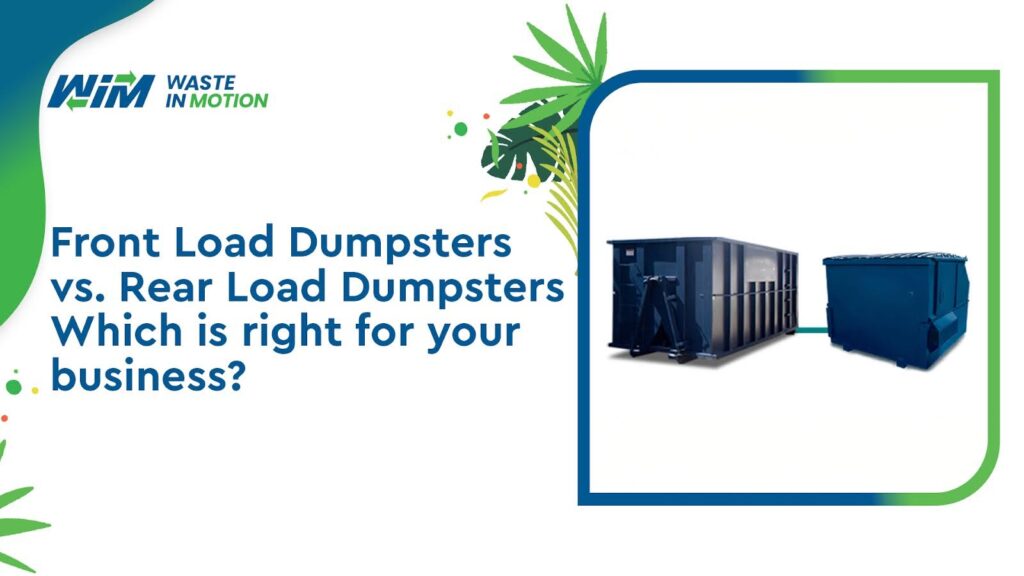Efficient waste management is a critical aspect of running a successful business. With an average brick-and-mortar generating substantial amounts of daily waste, proper disposal becomes paramount. As a business owner, you have likely considered dumpsters as a viable solution. However, choosing between front-load and rear-load dumpsters can be a complex decision, as each option has its advantages and disadvantages.
This guide aims to provide an in-depth comparison of front-load and rear-load dumpsters, facilitating you to determine the most suitable option for your business’s waste management needs. By understanding the pros and cons of each type, you can make an informed decision that aligns with your operational requirements and budget constraints.
Table of Contents
ToggleUnderstanding the Differences: Front Load vs. Rear Load Dumpsters
Front Load Dumpsters: The Versatile Option
We will call this “ The Versatile Option”.
Front load dumpsters are designed with a unique loading mechanism that allows waste collection containers to lift and empty them from the front. These dumpsters are a popular choice for businesses with high-waste output as they are engineered to handle large-scale waste management needs. They offer excellent accessibility for daily use and are ideal for regular, scheduled pickups.
Rear Load Dumpsters:
Rear Load Dumpsters are more of “ The Traditional Choice”
In contrast to front-load, these offer a more compact and versatile solution for businesses with smaller-scale waste handling needs or limited outdoor space. Rear load dumpsters are ideal for efficient waste disposal in tight spaces.
Key Features of Front Load Dumpsters
Front load dumpsters offer several advantages for commercial waste disposal, such as:
Large Capacity
One of the primary benefits of front load dumpsters is their large capacity. These dumpsters can accommodate significant volumes of waste. It reduces the need for frequent pickups and minimizes disruptions to your business operations.
Efficient Collection with Specialized Vehicles
Front load dumpsters require specialized collection vehicles equipped with hydraulic lift mechanisms. These vehicles are designed to lift and empty the dumpsters from the front efficiently. While this specialized equipment comes with a higher initial investment, it ultimately translates to increased efficiency and cost-effectiveness in the long run.
Suitable for Large Outdoor Areas
Front load dumpsters are best suited for businesses with ample outdoor space. Their larger footprint and the need for specialized collection vehicles necessitate adequate clearance and maneuvering room.
Businesses with limited outdoor areas may find front load dumpsters challenging to accommodate, as they may not have enough space for their size and the necessary collection equipment.
Advantages of Rear Load Dumpsters:
Space-Saving Design
Rear load dumpsters are typically more compact than their front-loading counterparts. This space-efficient design is ideal for businesses with limited outdoor areas, allowing for effective waste management without sacrificing valuable space.
Versatility in Placement
One of the key advantages of rear load dumpsters is their flexibility in placement. They can be positioned in areas that might be challenging for front loaders, such as against walls or in narrow alleyways. This versatility makes them an excellent option for businesses in urban settings or those with unique spatial constraints.
Cost-Effective for Smaller Volumes
Rear load dumpsters typically require less specialized equipment for collection, resulting in a lower initial investment compared to front load dumpsters. However, rear load dumpsters often have limited capacity compared to their front load counterparts, making them better suited for businesses with lower waste volumes.
Front Load Dumpsters vs. Rear Load Dumpsters: A Side-by-Side Comparison
Choosing between front load dumpsters and rear load dumpsters can significantly impact your business waste disposal options. To help you make an informed decision, let us compare these two side by side.
| Feature | Front Load Dumpsters | Rear Load Dumpsters |
| Typical Size Range | 2-8 Cubic Yards | 1-6 Cubic Yards |
| Capacity | Larger, ideal for high volume waste | Comparatively smaller, better for low-volume waste. |
| Loading Mechanism | Lifted from the front, harder for manual loading | Loaded from the rear, it is easier for manual loading |
| Truck Dependency | Needs specialized front loading trucks | Required rear-loading trucks. |
| Collection Frequency | Less frequent | More frequent |
| Collection Speed | Faster with automated trucks | Slower, requires manual labor |
| Durability | Built for heavy duty dose | Slower, requires manual labor |
| Space Requirements | Requires more space for placement and truck access | Fits into tighter spaces |
| Cost- Effectiveness | Better for high volume waste | Economical for lower values |
| Ideal For | Large businesses & building complexes | Small to medium businesses and homes |
Remember, the right choice depends on your specific needs and waste volume. Consulting with a professional waste management service can further guide you in selecting the most suitable option for your business.
Choosing the Right Dumpster for Your Business Needs
Costs and Maintenance Comparison:
Front load dumpsters typically have a higher upfront cost but require less maintenance over time. Their sturdy construction makes them more durable. They potentially last longer than rear load options.
Rear load dumpsters, while often cheaper initially, may incur higher maintenance costs due to more frequent repairs. However, they can be a cost-effective solution for businesses with lower waste volumes.
Environmental Impact and Sustainability
Both dumpster types play a role in modern waste management solutions, but their environmental impact differs.
Front load dumpsters are generally more efficient for large-scale waste collection. This reduces the number of trips required and lowers carbon emissions.
Rear load dumpsters can be strategically placed to encourage recycling initiatives. This feature of business waste disposal options can help align your company’s environmental goals with its waste management practices. This creates a more sustainable approach to waste disposal.
Considering Space and Accessibility
Front load dumpsters are ideal for businesses with limited space as they can be placed against walls or in tight corners. Rear load dumpsters, on the other hand, require more manoeuvring room for collection vehicles.
As you navigate the choice between front load and rear load dumpsters, it’s essential to carefully assess your business’s unique needs, considering factors like waste volume, available space and budget constraints. While front load dumpsters offer greater efficiency for large-scale waste collection, potentially reducing trips and carbon emissions, rear load options can be more cost-effective for lower waste volumes and facilitate recycling initiatives. By selecting the appropriate dumpster and developing good waste practices, you’ll contribute to a greener future for all!
FAQs
- What is the main difference between front-load and rear-load dumpsters?
Front load dumpsters are loaded from the front using a truck with hydraulic forks, while rear load dumpsters are loaded from the rear using a hoisting mechanism. Front load dumpsters are typically larger and more suitable for high-volume waste, while rear load dumpsters are smaller and more maneuverable for limited spaces.
- Which type of dumpster is more cost-effective for long-term use?
While front load dumpsters typically have a higher upfront cost, their durable construction and lower maintenance requirements make them more cost-effective for long-term use compared to rear-load dumpsters.
- Are front-load dumpsters better suited for larger businesses?
Yes, front-load dumpsters are generally better suited for larger businesses that generate high volumes of waste. Their larger capacity and efficient loading mechanism make them ideal for handling substantial waste streams from industrial facilities, construction sites, or large commercial buildings.
- How do I determine the right dumpster type for my business needs?
To determine the right dumpster type, consider factors like your waste volume, available space, and accessibility. Front-load dumpsters are suitable for high-volume waste and open spaces, while rear-load dumpsters are more maneuverable for limited spaces. Assess your site layout, waste generation rates, and budget to make an accurate decision.
- Can both front-load and rear-load dumpsters be used for recycling waste?
Yes, both front-load and rear-load dumpsters can be used for recycling waste. Rear-load dumpsters can be strategically placed to encourage recycling initiatives, making them a good option for businesses looking to align their waste management practices with environmental goals. Front-load dumpsters can also be utilized for recycling, particularly in high-volume waste scenarios.







